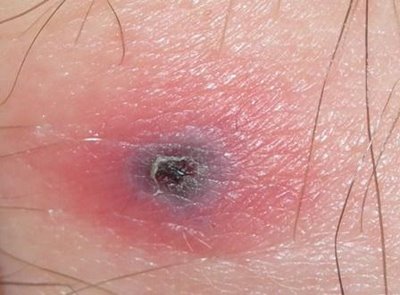Tick-borne disease (patient information): Difference between revisions
No edit summary |
No edit summary |
||
| Line 1: | Line 1: | ||
'''For the WikiDoc page for this topic, click [[Tick-borne disease|here]]''' | '''For the WikiDoc page for this topic, click [[Tick-borne disease|here]]''' | ||
{{ | {{Tick-borne disease (patient information)}} | ||
{{CMG}}; '''Assistant Editor(s)-in-Chief:''' Alexandra M. Palmer | {{CMG}}; '''Assistant Editor(s)-in-Chief:''' Alexandra M. Palmer | ||
Revision as of 17:55, 4 August 2011
For the WikiDoc page for this topic, click here
|
Tick-borne disease |
|
Tick-borne disease On the Web |
|---|
Editor-In-Chief: C. Michael Gibson, M.S., M.D. [1]; Assistant Editor(s)-in-Chief: Alexandra M. Palmer
Overview
Tick-borne diseases are diseases or illnesses transmitted by ticks. Hard- and soft-bodied female ticks are believed to make a poison that can cause tick paralysis in children. While most ticks do not carry diseases, some ticks can carry bacteria that can cause:
What are the symptoms of Tick-borne disease?
Watch for the symptoms of tick-borne disease in the weeks following a tick bite -- muscle or joint aches, stiff neck, headache, weakness, fever, swollen lymph nodes, and other flu-like symptoms. Watch for a red spot or rash starting at the location of the bite. The symptoms below refer more to the problems resulting from the bite itself, not the diseases that a bite may cause. Some of the symptoms are specific to one variety of tick or another but not necessarily common to all ticks.
- Apnea (breathing stopped)
- Blisters
- Difficulty breathing
- Rash
- Severe pain at bite site (some varieties), lasting for several weeks
- Swelling at bite site (some varieties)
- Weakness
- Uncoordinated movement
Who is at risk for Tick-borne disease?
People who spend time outdoors and/or have pets that go outdoors are at risk for tick-borne disease.
How do I know I have Tick-borne disease?
A round red rash with a 2-5 mm central black area (eschar, an area of dead tissue) as shown in the photo is suggestive of a tick bite.

Prevention of Tick-borne disease
Avoid places where ticks reside. Ticks live in wooded or grassy fields.
Treatment options
Remove the tick. Be careful not to leave the tick's head stuck in the skin. If there is a collection of pus, the area will need to be incised and drained. Antibiotic treatment is often justified based on clinical presentation alone. Doxycycline is often used to treat suspected tick-borne disease. Usually one dose is given to cover Lyme disease. An IV dose of a cephalosporin followed by Keflex 500 mg PO q 6 hours is given to treat the surrounding cellulitis. For hospital workers and others who have recently been in the hospital, bactrim twice a day is given to cover Methicillin-resistant Staphylococcus aureus (MRSA).
Where to find medical care for Tick-borne disease
Directions to Hospitals Treating Tick-borne disease
What to expect at the emergency room
The symptoms will be treated as appropriate. Long-term treatment may be needed if complications develop. Preventive antibiotics are often given to people who live in areas where Lyme disease is common.
What to expect (Outlook/Prognosis)
Most tick bites are harmless. The outcome will depend on what type of infection the tick may have been carrying and how soon appropriate treatment was begun.
Sources
http://www.nlm.nih.gov/medlineplus/ency/article/002856.htm
Template:SIB Template:WH Template:WS Template:WH Template:WS